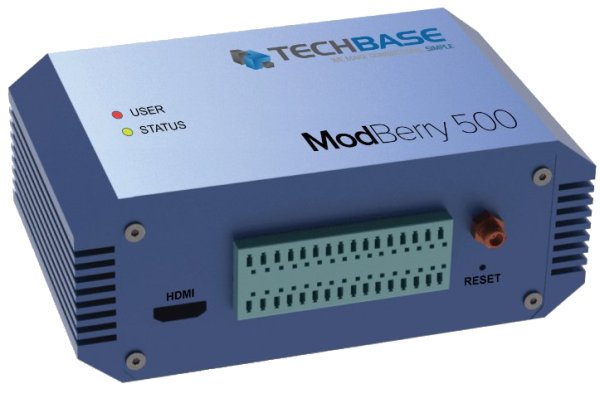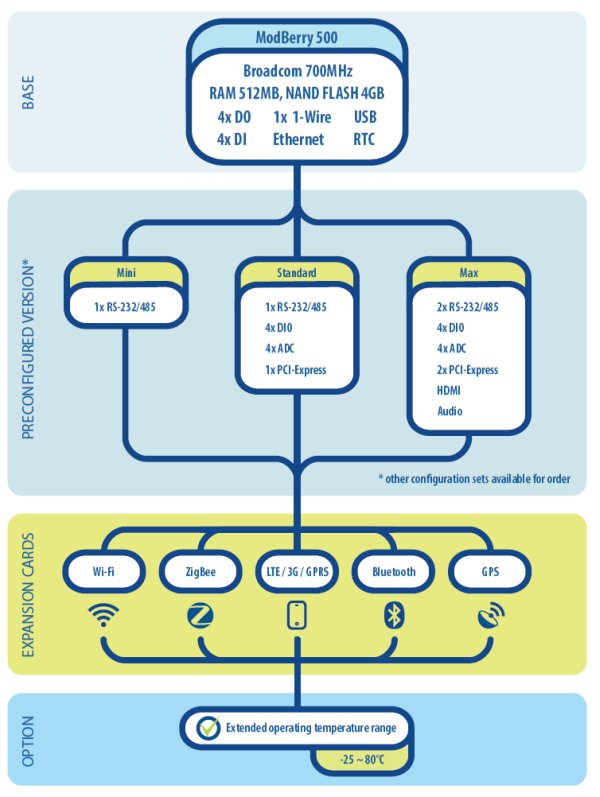Techbase has designed a Raspberry Pi Compute Module into a Linux-based “ModBerry” automation computer backed by an “iMod” cloud platform for remote control.
The computer-on-module version of the Raspberry Pi Compute Module, which began shipping this week, was anticipated by many, but perhaps nowhere so acutely as in Poland. First, we heard about A Sherlybox private cloud storage device based on the module from Polish startup Sher.ly, and now Gdansk-based industrial computer manufacturer Techbase has opened pre-orders for an automation computer called the ModBerry 500 based on the COM.
Farnell Element 14 and RS Components both released the Pi module as part of a development kit costing 126 Pounds ($215) and 142 Pounds ($241), respectively. The Raspberry Pi Compute Module Development Kit, which includes a separate baseboard, will be followed later this summer by the module on its own, which will be priced around $30 in quantities of 100, and slightly higher for single units.
Techbase offers a number of Linux-based and Linux-ready industrial computers and automation controllers. Like the ModBerry, some of these, including the iMod-X1000 telemetry computer, are supported with the company’s cloud-based iMod, iModCloud, and iModWizard Software-as-a-Service (SaaS) applications. Whereas the Sherlybox creates a private crowd based on local storage, the iMod ecosystem allows data storage and control of various iMod compatible computers via a cloud platform.
The combination of the ModBerry 500 and the iMod software enables applications in the general automation market, intelligent buildings, as well as the monitoring and control of power stations, GSM base stations, and wind farms, says Techbase. The device can be set up as a protocol converter, data logger, telemetry module, server, PLC device, MODBUS router, SNMP agent, and much more.
The iMod system offers multi-leveled, user access cloud management based on configuration files. Thanks to the iModWizard, no programming knowledge is required, says Techbase. You can create different user profiles such as system designer, administrator, and end-user, and update software and configure services via iModCloud, says the company.
The iModCloud platform provides file management, notifications, and custom-based actions. Data visualization capabilities include maps that show the location of GPS-enabled devices. Access to the data is available via smartphones or tablets, and security is handled via SSL certificates and encrypted VPN communication.
Inside the ModBerry 500
The ModBerry 500 measures 106 x 91 x 61mm, and has a wide-ranging 9-24V AC/DC power supply. It’s available in commercial and extended (-25 to 80°C) models.
The Raspberry Pi Compute Module provides the ModBerry 500 with the Raspberry Pi’s 700MHz, ARM11 Broadcom BCM2835 system-on-chip running Raspbian Linux. The module also supplies 512MB of RAM and 4GB NAND flash storage.
Techbase builds on this foundation with a handful of real-world ports on one side, including a USB 2.0 host port, a 10/100 Ethernet port, a SIM card slot, audio out, and a programmable user button. On the other side there’s an HDMI port, a reset button, and a bank of pinouts supporting the remainder of the I/O.
Interfaces include a pair of RS-232 and RS-485 ports, respectively, as well as a CAN port and a 1-Wire bus. There are also a variety of digital inputs and outputs, as well as analog inputs. A second USB 2.0 port is available via an internal header. One or two PCI-Express expansion slots are also available.
You can add up to two wireless expansion cards, choosing among five options: WiFi, cellular (including LTE), GPS, Bluetooth, and ZigBee. Additional options include power feeders, antennas, 1-Wire sensors, M-Bus converters, and ZigBee sensors and relays.
Judging from the diagram above, there appears to be a lot of customization available, with Mini, Standard, and Max editions offering differing levels of I/O. We’ve listed the specs for the Max below.
An expanded developer’s platform offers additional software including SMS, Apache, SSH, GPS, and Python/Ruby/Java/PHP packs. This also includes data managers like PostgreSQL, MSSQL, and SQLite, as well as an Open VPN module and a homegrown NXDynamics package for drag-and-drop WWW visualizations and NPE management.
Specifications listed for the ModBerry 500 Max include:
- Processor (via Raspberry Pi Compute Module) — Broadcom BCM2835 (1x ARM11 @ 700MHz); Broadcom VideoCore IV GPU
- Memory (via Raspberry Pi Compute Module) — 512MB SDRAM; 4GB eMMC flash
- Wireless (via up to 2x of 5x optional expansion cards):
- 802.11 b/g/n, up to 150Mbps (64/128-bit WEP, WPA, and WPA2)
- LTE/3G/GPRS
- GPS module
- Bluetooth
- ZigBee
- SIM card slot (standard)
- Networking — 10/100 Ethernet port
- Real-world ports:
- USB 2.0 host port
- HDMI port
- Audio out jack
- User button
- Other I/O:
- 2x RS-232
- 2x RS-485
- CAN
- 1-Wire
- 4x digital input
- 4x digital output
- 4x configurable DIDO
- 4x analog input
- USB 2.0 (internal header)
- Expansion — 1x or 2x PCIe
- Other features — RTC; watchdog; reset button; LEDs
- Software/services — iMod, iModCloud, and iModWizard; optional expanded developer platform
- Options — Wireless modules (see above), plus power feeders, antennas, 1-Wire sensors, M-Bus converters, ZigBee sensors and relays
- Power — 9-24V AC/DC, 1000mA
- Operating temperature — 0 to 70°C commercial model or -25 to 80°C extended temp. model
- Weight — 300 g
- Dimensions — 106 x 91 x 61mm; DIN-mountable
- Operating system — Raspbian (Linux 3.6)
For more detail: Automation controller taps Raspberry Pi Compute Module



